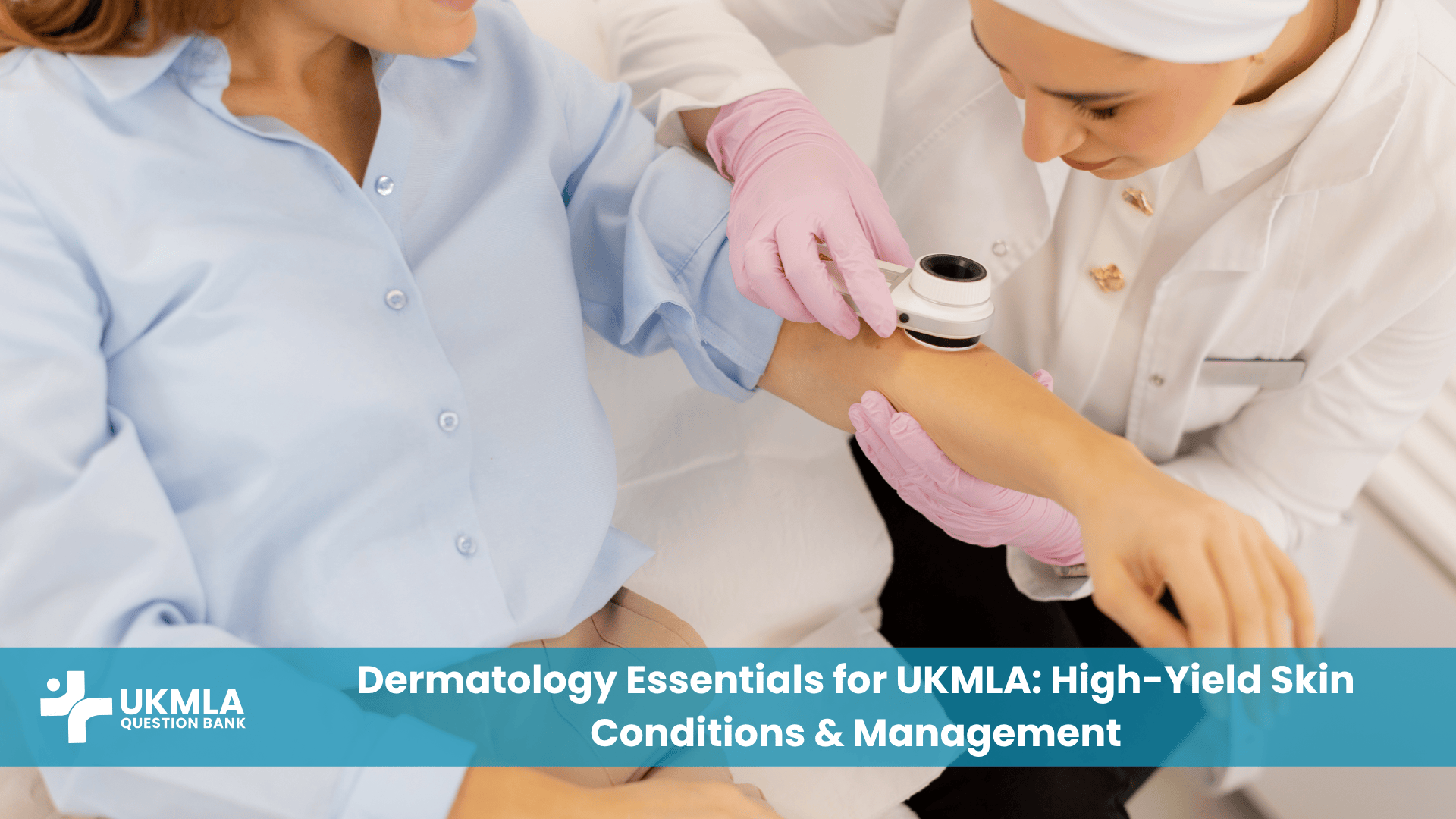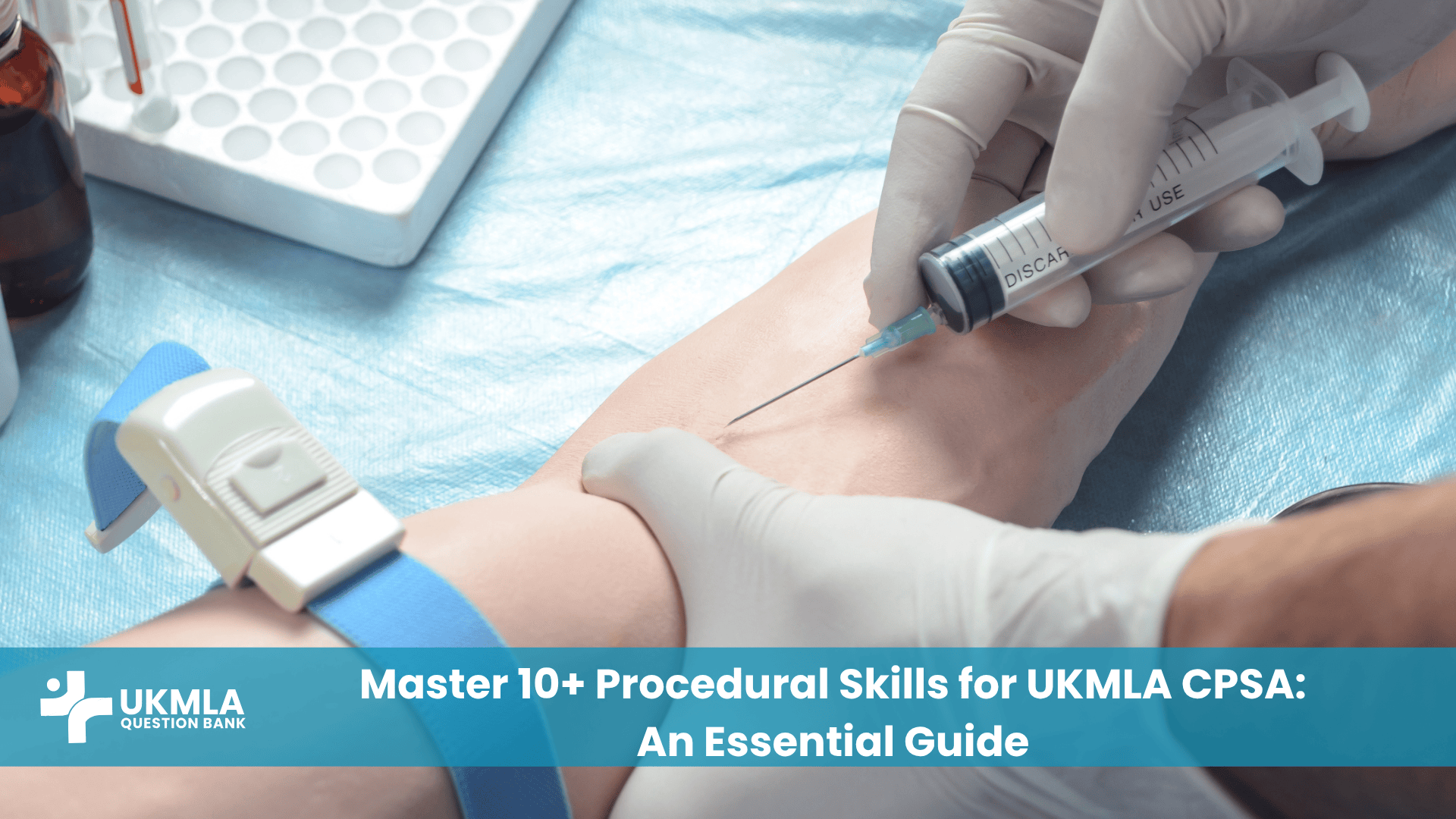While often viewed as a niche specialty, dermatology is a surprisingly high-yield and critically important topic for the UKMLA Applied Knowledge Test (AKT). Skin conditions are incredibly common in primary and secondary care, ranging from simple rashes to life-threatening malignancies. A strong understanding of the core UKMLA dermatology essentials is crucial for demonstrating your readiness for safe practice as a UK junior doctor. The UKMLA will test your ability to recognize key presentations, formulate differential diagnoses, and initiate appropriate management for these conditions.
This guide provides a focused overview of the most important UKMLA dermatology essentials. We will concentrate on the high-yield conditions you are most likely to encounter on the exam, including common infections, inflammatory dermatoses, and the key features of skin cancers. By mastering these core topics, you can build a solid foundation to confidently tackle dermatology-related Single Best Answer (SBA) questions and secure valuable marks on your UKMLA AKT.
Key Takeaways
Before we examine the conditions in detail, here are the core principles for mastering UKMLA dermatology essentials:
Focus on the Common and the Critical: Prioritize prevalent conditions like eczema, psoriasis, acne, common skin infections, and crucially, the recognition of skin cancers.
Learn the Language: Be precise with dermatological terms (e.g., macule, papule, plaque, vesicle) as they are key to interpreting clinical vignettes.
Recognize Patterns: Many skin conditions have classic distributions and morphologies. Learning these patterns is essential for diagnosis.
Master the Management Ladder: For conditions like acne and eczema, understand the stepwise approach to treatment, from conservative measures to specialist therapies.
Know When to Refer: A key tested competency is knowing the red flags that necessitate urgent referral to a dermatologist, especially for suspected malignancies.
Practice Visual Recognition: Use question banks with high-quality images to hone your ability to recognize conditions visually. This is a core part of studying UKMLA dermatology essentials.
Understand Topical Steroid Potency: Have a basic understanding of the steroid ladder and when to use mild, moderate, potent, or very potent topical steroids.
Why Dermatology is a High-Yield Component of the UKMLA
Dermatological problems account for a significant percentage of GP consultations and are frequently encountered on hospital wards. The UKMLA’s focus on “readiness for safe practice” means you must be competent in this area.
Prevalence in UK Clinical Practice
From a baby with atopic eczema to an elderly patient with a suspicious lesion, skin conditions affect all age groups. As an FY1 doctor, you will be expected to manage common dermatological issues and, most importantly, recognize when a seemingly simple skin problem could be a sign of a serious underlying disease or a malignancy needing urgent attention. This practical relevance makes the subject a high-yield area for the UKMLA.
Aligning Your Dermatology Revision with the UKMLA Content Map
The GMC’s UKMLA Content Map is your definitive guide to what you need to know. It specifically lists presentations like “Skin rashes,” “Lumps, bumps and skin lesions,” and “Itch.” To effectively prepare, you should map these presentations to the common conditions discussed in this guide.
Focusing your study of UKMLA dermatology essentials based on this official blueprint ensures your revision is targeted and efficient. For a deeper understanding of how to use this resource, our guide on “How to Use the GMC UKMLA Content Map to Structure Your Revision” is highly recommended.
The Visual Nature of Dermatology Questions
Dermatology is a visual specialty, and the UKMLA AKT often incorporates images into its SBA questions. You may be shown a picture of a skin lesion or rash and asked for the most likely diagnosis, the most appropriate investigation, or the next step in management. This is why simply reading text is not enough; you must train your visual recognition skills with image-based practice questions.
Infectious Dermatology: Common Culprits and Their Management
Infections of the skin are extremely common. Mastering these UKMLA dermatology essentials is crucial for any aspiring UK doctor.
Viral Infections: Herpes Simplex and Varicella-Zoster
Herpes Simplex (Cold Sores/Genital Herpes): Recognize the classic grouped vesicles on an erythematous base. Understand the difference between primary and recurrent infections and know that the first-line treatment is with oral aciclovir.
Varicella-Zoster Virus (VZV): Be able to identify both chickenpox (widespread, itchy vesicles in various stages of healing) and shingles (a painful, dermatomal vesicular rash that does not cross the midline). Know that shingles requires prompt treatment with oral antivirals to prevent post-herpetic neuralgia.
Bacterial Infections: Impetigo and Cellulitis
Impetigo: A superficial skin infection, classically presenting with “golden-crusted” lesions, typically around the mouth and nose of children. It is highly contagious and usually caused by Staphylococcus aureus or Streptococcus pyogenes.
Cellulitis: A deeper infection of the dermis and subcutaneous tissue. It presents as a hot, tender, swollen area of erythema with ill-defined borders. Know the common causative organisms (Staph/Strep) and that management involves antibiotics and elevation of the affected limb.
Highlight: A key skill is differentiating cellulitis from other causes of a red, swollen limb, such as a deep vein thrombosis (DVT) or venous eczema. The clinical context is vital.
Fungal Infections: The Tineas
Fungal infections are common and often named by their location.
Tinea Corporis (Ringworm): Presents as an itchy, annular (ring-shaped) plaque with a raised, scaly border and central clearing.
Tinea Pedis (Athlete’s Foot): Maceration and scaling between the toes.
Tinea Cruris (Jock Itch): Itchy rash in the groin folds. The diagnosis is usually clinical, but skin scrapings can be sent for mycology. Treatment is typically with topical or oral antifungal medications.
| Infection Type | Classic Presentation | Key Management Principle |
|---|---|---|
| Viral (Shingles) | Painful, vesicular rash in a single dermatome. | Prompt oral antiviral therapy (e.g., Aciclovir). |
| Bacterial (Cellulitis) | Hot, tender, swollen erythema with ill-defined borders. | Systemic antibiotics (e.g., Flucloxacillin) and limb elevation. |
| Fungal (Tinea Corporis) | Annular plaque with a raised, scaly border. | Topical or oral antifungal agents (e.g., Terbinafine). |
Inflammatory Dermatoses: Eczema, Psoriasis, and Acne
Chronic inflammatory skin conditions are a cornerstone of UKMLA dermatology essentials due to their high prevalence and impact on quality of life.
Atopic Eczema: Diagnosis and Stepwise Management
Atopic eczema (atopic dermatitis) is a chronic, itchy inflammatory skin condition common in children but also affecting adults.
Presentation: Look for ill-defined, dry, red, itchy patches, typically in flexural areas (e.g., front of elbows, back of knees) in older children and adults.
Management Ladder: This is a classic exam topic. The approach is stepwise:
Baseline: Emollients (moisturizers) used liberally and frequently.
Mild Flares: Add a mild-potency topical steroid (e.g., hydrocortisone 1%).
Moderate Flares: Use a moderate-potency topical steroid (e.g., betamethasone valerate 0.025%).
Severe Flares: May require potent topical steroids, wet wraps, or specialist referral. The NICE CKS on Atopic Eczema provides the detailed management pathways you should be familiar with. An alternative suggestion is the European Guideline (EuroGuiDerm): Living EuroGuiDerm Guideline for the systemic treatment of Atopic Eczema | EDFG
Psoriasis Vulgaris: Classic Signs and Treatment Principles
Psoriasis is another common chronic inflammatory condition.
Classic Presentation: Well-demarcated, red plaques with a silvery scale, typically found on extensor surfaces (e.g., elbows, knees), the scalp, and the sacrum.
Nail Signs: Look for nail pitting or onycholysis (separation of the nail from the nail bed).
Management: Treatment depends on severity. Mild-to-moderate disease is managed with topical agents like vitamin D analogues (e.g., calcipotriol) and topical steroids. Severe disease may require phototherapy or systemic biologic agents under specialist care.
Acne Vulgaris: Management Ladder
Acne is an incredibly common condition in adolescents and young adults. The management follows a clear stepwise ladder, which is high-yield for exams.
“The management of acne is a perfect example of a therapeutic ladder. A candidate must know the steps, from topical treatments to oral antibiotics and specialist options like isotretinoin, to demonstrate competence.” – (Attributed to a Dermatology Registrar).
| Severity | First-Line Treatment | Second-Line / Additional Options |
|---|---|---|
| Mild (Comedonal) | Topical retinoids (e.g., adapalene) or benzoyl peroxide. | Combination topical therapy. |
| Moderate (Papulopustular) | Combination topical therapy (e.g., retinoid + antibiotic). | Add oral antibiotic (e.g., lymecycline, doxycycline) for 3-6 months. |
| Severe (Nodulocystic) | Oral antibiotics combined with topical therapy. | Refer to a dermatologist for consideration of oral isotretinoin. |
Skin Cancer: The Most Critical UKMLA Dermatology Essential
Recognizing and appropriately referring suspected skin cancer is one of the most important safety-critical skills you will be tested on.
Basal Cell Carcinoma (BCC) & Squamous Cell Carcinoma (SCC)
These are the most common skin cancers, often referred to as non-melanoma skin cancers.
BCC: Classically a pearly, pink papule with telangiectasia (visible small blood vessels). It may have a rolled border and central ulceration. They are slow-growing and locally invasive but rarely metastasize.
SCC: Typically a firm, irregular, keratinized (scaly or crusted) plaque or nodule that may ulcerate. They grow faster than BCCs and have a higher potential for metastasis.
Malignant Melanoma: The ABCDE Rule and Urgent Referral
Malignant melanoma is the most dangerous skin cancer. Your primary role is recognition and urgent referral. The ABCDE rule is a vital tool for assessing suspicious pigmented lesions:
Asymmetry: One half of the mole does not match the other.
Border: The edges are irregular, ragged, or blurred.
Colour: The colour is not uniform and may include shades of black, brown, tan, red, or blue.
Diameter: The mole is larger than 6mm (the size of a pencil eraser), though smaller melanomas exist.
Evolving: The mole is changing in size, shape, or colour.
Highlight: Any pigmented lesion with features suggestive of malignant melanoma based on the ABCDE rule requires an urgent two-week-wait (2WW) referral to dermatology. This is a critical safety point for the UKMLA.
Key Premalignant Lesions
You should also be able to recognize common premalignant lesions.
Actinic (Solar) Keratosis: Rough, scaly patches on sun-exposed skin. They are considered precancerous and can develop into SCC.
Bowen’s Disease (SCC in situ): A well-demarcated, slowly enlarging red, scaly plaque. It is a full-thickness dysplasia of the epidermis.
For further authoritative information, resources like the General Medical Council (GMC) set the standards for knowledge expected of graduating doctors.
Supercharge Your UKMLA Prep with UKMLAquestionbank.com
Effectively mastering the visual and theoretical aspects of UKMLA dermatology essentials is made easier with targeted practice. UKMLAQuestionBank.com is specifically designed to help you succeed.
Our platform offers an extensive UKMLA question bank filled with high-yield, clinically-oriented questions that mirror the style and complexity of the actual exam, many including high-quality images of dermatological conditions. Each question comes with detailed explanations that not only clarify the correct answer but also reinforce underlying clinical principles and management pathways.
With UKMLAQuestionBank.com, you benefit from:
Focus on Clinical Reasoning: Our questions are designed to test your diagnostic and management skills, not just rote recall.
Performance Analytics: Track your progress and identify areas within dermatology where your knowledge needs strengthening.
Flexible Learning: Access our resources anytime, anywhere, making it easier to fit study around your clinical commitments.
Frequently Asked Questions (FAQ) on Your UKMLA Dermatology Questions Answered
Very important. You should be able to classify steroids as mild (e.g., hydrocortisone), moderate, potent (e.g., betamethasone dipropionate), and very potent (e.g., clobetasol). Knowing which to use for different body parts (e.g., mild for the face) is a key part of the UKMLA dermatology essentials.
This is highly unlikely. The UKMLA focuses on common conditions that a junior doctor is expected to manage or recognize. Focus your study on the high-yield topics mentioned in this guide.
No. As a candidate for medical licensing, you are expected to recognize the clinical features and initiate referral. Histology is the domain of pathologists and dermatologists.
While plaque psoriasis is the most important, you should recognize guttate psoriasis (small, “drop-like” plaques often following a streptococcal throat infection) as it’s a classic presentation.
Yes. Recognizing common drug eruptions like a morbilliform rash or urticaria is a key competency. Being able to identify a potential drug cause and knowing to stop the offending agent is a critical part of the UKMLA dermatology essentials.
You are unlikely to need to perform a detailed calculation, but you should understand the principle and know that widespread disease (e.g., >10% BSA) often requires specialist management.
This refers to a mole that looks different from all the other moles on a person’s body. It stands out as being different and should be considered suspicious, even if it doesn’t meet all the ABCDE criteria.
Be systematic. Use the “SCAM” mnemonic: Site (where is it?), Characteristics (macule, papule, plaque, etc.), Arrangement (annular, linear, dermatomal), and Morphology (the overall pattern).
A combination is best. Use a textbook or reliable online resource to build your foundational knowledge of the UKMLA dermatology essentials, then use a question bank with images to practice applying that knowledge and train your visual recognition.
Without a doubt, any lesion suspicious of malignant melanoma or rapidly growing squamous cell carcinoma. Knowing the criteria for an urgent two-week-wait referral is a critical safety issue.
Conclusion: A Clear-Sighted Approach to UKMLA Dermatology
Dermatology is a rewarding and essential component of medical knowledge that is heavily represented in the UKMLA. By focusing your revision on the UKMLA dermatology essentials—common infections, key inflammatory dermatoses, and the vital skill of recognizing skin cancer—you can turn this subject into one of your strengths.
Combine structured learning with extensive practice from image-based question banks to build both your theoretical knowledge and your visual diagnostic skills. A confident, systematic approach to dermatology will not only help you secure a high score on the AKT but will also make you a safer and more competent doctor from your very first day on the wards.
Ready to master the UKMLA dermatology essentials? Empower your revision with targeted, image-rich practice questions. Explore the comprehensive resources at UKMLAQuestionBank.com and start building your confidence today!
Conquer Dermatology for the UKMLA!
Don’t let skin conditions be your weak spot. Access high-yield notes, image-based questions, and proven strategies designed to help you ace the dermatology component of the UKMLA AKT.
[Explore Our UKMLA Dermatology Resources Now!]



